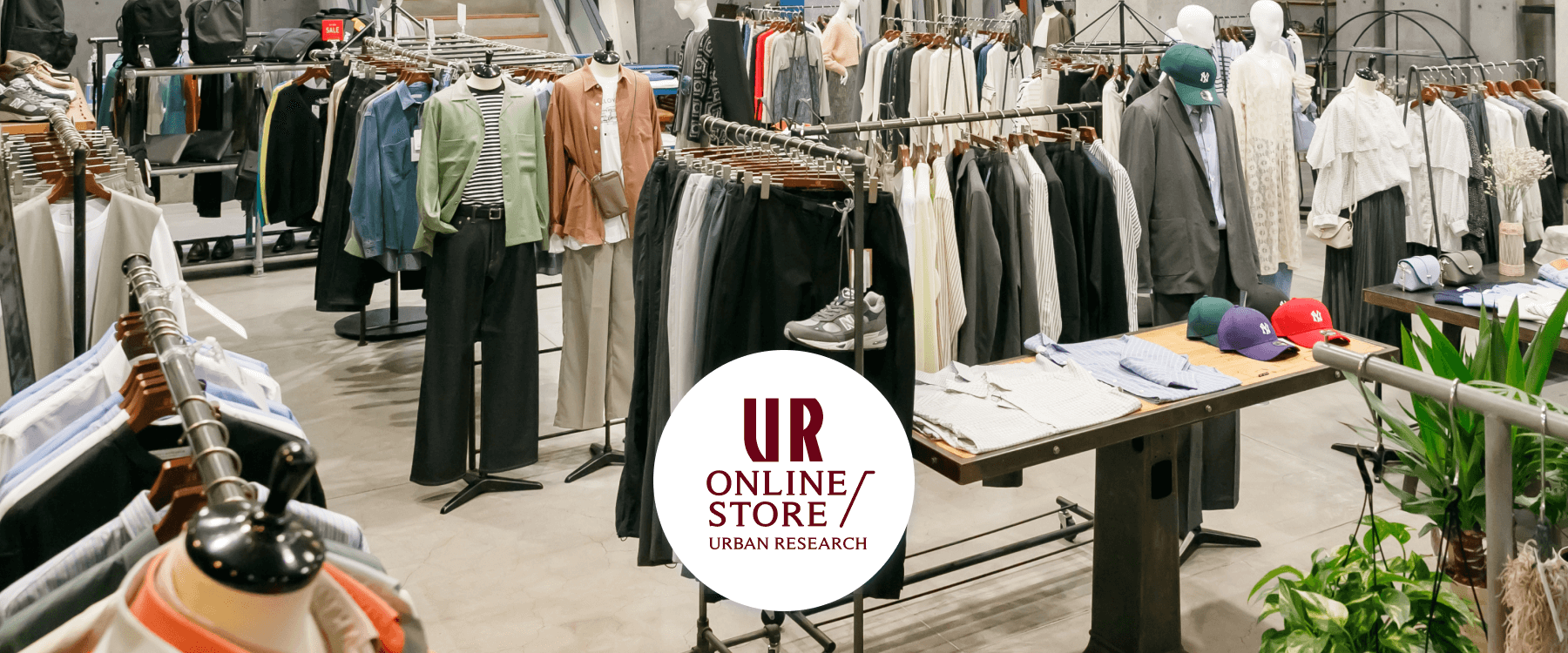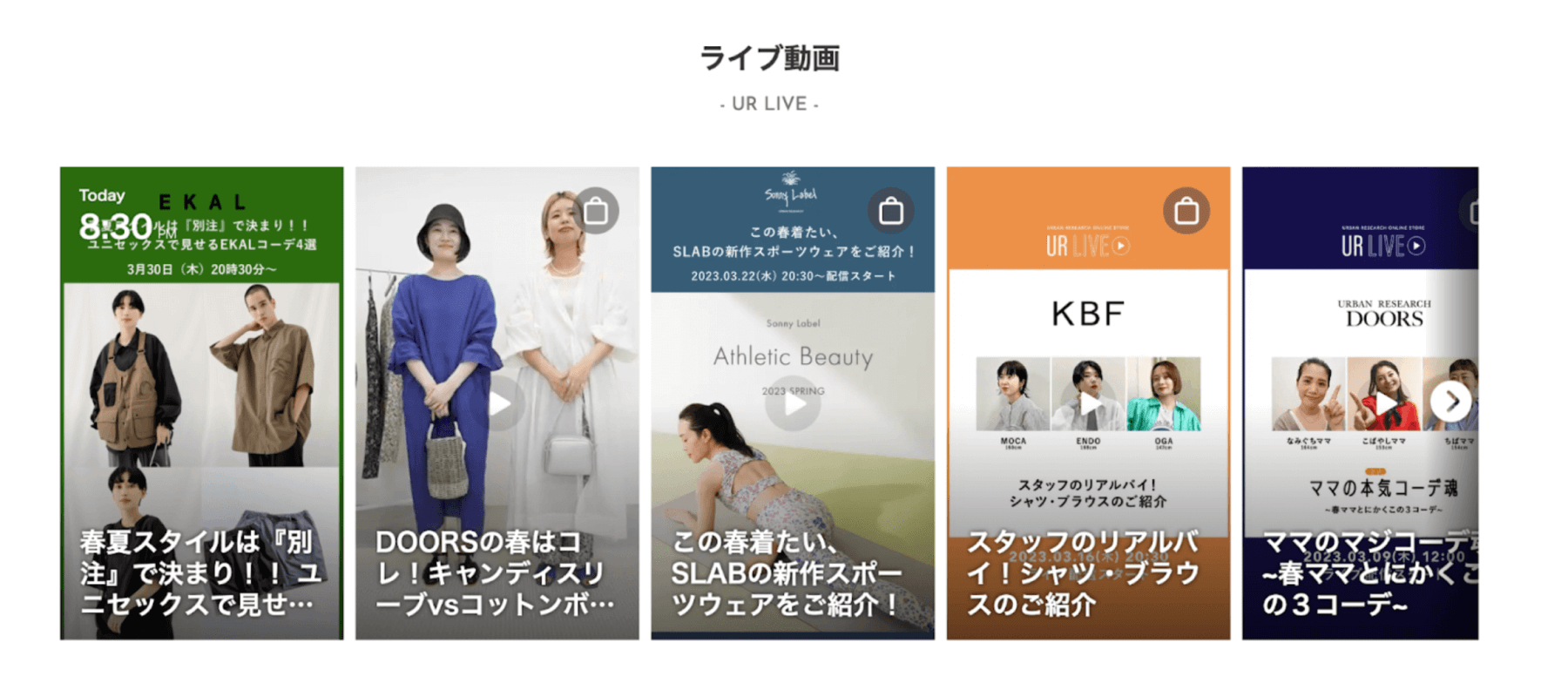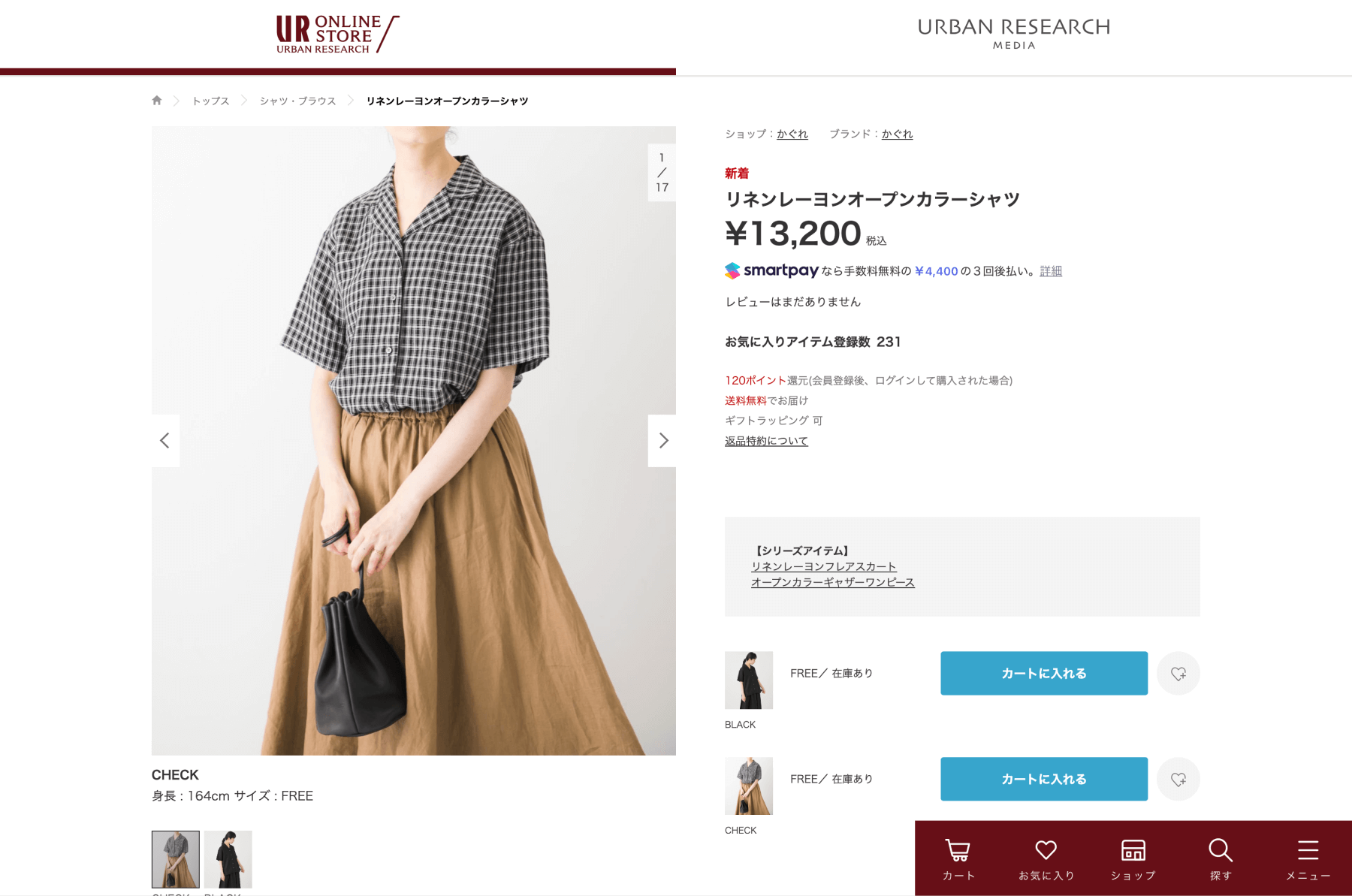
Introducing digital financing increased e-commerce site average purchase price by 60%!
How can you produce a popular apparel e-commerce site by maximizing the customer experience?
Online shopping is becoming mainstream in the fashion and apparel industry. Brands that originally focused on major e-commerce malls are now competing to improve the online shopping experience by concentrating on strengthening their own e-commerce sites and on-demand media operations.
This, coupled with changes in consumer behavior, such as people who used to only shop at brick-and-mortar stores but now also visit the brand’s e-commerce site to make purchases, will make it increasingly important to create a customer experience that integrates the brick-and-mortar store and the e-commerce site.
So, what action can e-commerce sites take to improve online and offline buying experiences?
We interviewed two people from Urban Research Co., Ltd., a company that has garnered attention for new approaches to improving the customer experience on its site.
Urban Research has OMO (online merges with offline) in mind by taking an omni-channel approach that integrates brick-and-mortar stores with the company’s e-commerce site.
In this interview, we asked Mr. Komurasaki and Mr. Shirie, from Urban Research’s Digital Sales Department, what action they’re taking to improve the customer experience on their e-commerce site.
We also discussed how their Smartpay digital financing service is leading to better add-to-cart conversion rates and higher unit prices.

Shinya Komurasaki | Manager, Digital Sales Dept., Urban Research Co., Ltd.
Began working at Urban Research in 2006 in the EC Department, where he was involved in managing the company’s website and external mall websites. Currently in the Digital Business Department’s CRM Section.

Takaaki Shirie | Manager, Design Section, Digital Sales Department, Urban Research
Joined the company in 2014. As a manager in the Design Section, responsible for UI/UX design and on-demand media content creation. Currently involved in improving the customer experience, optimizing marketing action, and advancing DX within the department.
Urban Research Co., Ltd. operates select shops selling clothing and accessories. The company runs 206 apparel stores across Japan and its own official online store, the Urban Research Online Store.
—— Tell us about your current department and position, as well as your career leading up to that.
Shirie: I am a manager in a unit called the Design Section, which is part of the Digital Sales Department at Urban Research Co., Ltd.
Originally, I was primarily responsible for updating e-commerce owned media, but as e-commerce accounted for a larger amount of business over time, I began to work in UI/UX to renew the site and applications and launch a video site as part of our efforts to strengthen e-commerce.
Currently, as an extension of that work, I’m working on CX (customer experience), which involves me in planning to plot out customer journeys and improve the customer experience.
As for my career, I started out in sportswear planning and design. After working in vintage clothing and sneaker purchasing, and then wholesale and retail, I worked in the IT industry as a web director, and then joined Urban Research in 2014.
Komurasaki: I’m also in the Digital Sales Department, like Shirie, but I’m in two units. One is the CRM Section and the other is the Administrative Section.
In the CRM Section, I’m in charge of customer touchpoints and I handle customer service via the e-commerce site.
In the Administrative Section, I oversee everything: accounting, distribution, order management, and coordination with external malls, and so on. I also facilitate omni-channel services such as layaway and pick-up services.
Prior to my current position, I have been involved in e-commerce ever since Urban Research hired me in 2006.
To improve the customer experience, content has to start with stores and people, rather than having a digital origin.
—— We’ve previously heard that you are working on ways to improve the customer experience. Recently, you’ve been focused on live-streaming fitting sessions, right?
Shirie: Yes. On the e-commerce site, a product’s page will have information about it, but it’s hard to convey the product’s details with still images.
We thought we could provide more detailed information with video, so we started live streams.
Live streams allow the clerks who serve customers in the stores to share the products’ features and deliver more realistic information about how to wear the products and the materials they’re made of.

Viewers can also post comments during a live stream so we can engage in real-time communication with customers.
For example, they can ask questions about a product just like they would to a clerk in a brick-and-mortar store. They might say, “I’m concerned about the length” or ask, “What can I coordinate this with?”
—— Are there other things you’re focusing on to improve the customer experience, regardless of channel?
Komurasaki: We’re focusing on several areas. One is “styling content” which involves clerks introducing coordinated outfits.
This content has always been popular, but now we’re trying to make it even better.
We’re also focusing on one-to-one marketing to roll out marketing tailored to the needs and purchase history of each customer.
For example, if a person has only purchased from a brick-and-mortar store, we can try giving them a coupon redeemable on the e-commerce site.
For those who have not made a purchase in a year, we can give them a coupon to get them to visit the site.
We’ll also sometimes give out coupons to encourage repeat purchases.
To encourage specific behavior, we fragment segments and vary the reach between each one.
—— Urban Research has been rolling out action to improve the customer experience with OMO in mind, which involves thinking about the physical store and the e-commerce site collectively.
Tell us about any changes during this process among users or changes in the purchasing experience that you two have noticed recently.
Komurasaki: During the pandemic, people used the e-commerce site more and watched more live video.
Sales on the e-commerce site were increasing, but in certain categories, such as shoes and pants, they weren’t growing at all.
We observed customers wanting to try on and buy those items in stores because it can be hard to find the right size for shoes or pants on an e-commerce site.
Some people check the e-commerce site and then visit a store to make the actual purchase, or vice versa, while some buy in a store and then check the site for how to coordinate the item.
I get the impression that this behavior is coming naturally for more and more people, so coexistence between brick-and-mortar stores and e-commerce sites will remain crucial in the future.
Shirie, you saw that kind of behavior in the numbers, didn’t you?
Shirie: That’s right. In fact, we cross-referenced behavioral data from the e-commerce site with purchasing data from brick-and-mortar stores to conduct an in-depth analysis of how people who made purchases at the stores were behaving on the site.
We’d already been talking about proceeding with an OMO approach, so we did an analysis to find out what kind of people would be cross-users.
The analysis revealed that among customers who had only made purchases in brick-and-mortar stores and never on the e-commerce site, 20% of those sales came from shoppers who had browsed the site beforehand.
Until now, we’d only looked at the behavior history on the e-commerce site and assumed they were simply visitors who didn’t convert. But now we know they were actually hidden heavy users.
There were also users whom we assumed would buy a product in a store after viewing the product page on the e-commerce site, but when we were analyzing the behavioral data, we realized that many of them viewed the product page on the site only after buying the product in the store.
And then there are those who come back to the site every day to see ways to coordinate their purchases.
When considering what an e-commerce site should be like in the future, we’re not only trying to increase the number of cross-use customers, but we’re also considering what kind of customer experience best fits the people who use both the site and stores.
In particular, we have often thought of the content we provide from a digital perspective, but we are now planning it with the idea that there should be more content in a digital format that originates with stores and people.
Digital financing at the point of checkout were one way we improved the add-to-cart conversion rate.
—— We understand you’re working on ways to improve sales and the customer experience on your e-commerce site. Are you struggling with any challenges?
Shirie: I think speed is a challenge. Even if we plan and implement various solutions, it takes time to release them when development becomes involved.
We’re looking hard for a solution that can address it. We want to increase the speed by introducing tools that allow us to easily conduct A/B testing and change content.
The next question is how to reduce the add-to-cart conversion rate (i.e., users who add products to their carts on e-commerce sites but leave without making a purchase, or users who leave products in their carts on e-commerce sites).
—— Statistical data also shows that Japan has a higher add-to-cart conversion rate than other countries. How does this behavior look to Urban Research?
Shirie: I think this happens more often when users have to take more time to think.
For example, the sum they see when they select a product may be different at the payment screen, and this may cause them to leave an item in the cart.
I think users leave because they’re concerned about something. Sometimes, 40% to 50% of people will put something in their cart, but only a small percentage actually makes a purchase, so we’ve been wondering how we can reduce unpurchased items in carts.
We were wondering if we could use a digital financing payment option like Smartpay as a solution to this problem.
I imagine that someone who is set on spending no more than 30,000 yen per month on clothing would surely have trouble buying something for 100,000 yen.
If we had a pay later option, then we thought that might reduce the number of unpurchased items in shopping carts.
—— So even though a certain number of people use credit cards, adding options for digital financing payment or payment in installments on the payment screen would increase both the purchase rate and the average unit price?
Shirie: That’s right. Apple Pay Later was in the news recently. It’s among the many new digital financing payment services coming out now.
I think pay later options will gradually spread as a means of settlement and become more commonplace.
—— Other payment services also offer digital financing payment, and it seems it’s going to become the standard.
And if it becomes available in stores, the number of users will likely increase, as we’ve seen in the U.S.
The many department stores there advertising the option give the impression that they are putting it front and center.
Komurasaki: Since subscriptions are becoming more and more commonplace in the world, it seems that some people want to spread out their shopping expenses.
As I mentioned earlier, some people have decided to limit their monthly clothing expenses to 30,000 yen.
Rather than buying in lump sums when they’ve saved up enough money, the trend seems to be heading toward paying in monthly installments.
Introducing digital financing lowers the purchasing hurdle for shoppers.
—— What changes have you seen since introducing Smartpay?
Komurasaki: The average price per purchase is 60% higher for those who pay with Smartpay.
If Smartpay’s share of total sales increases, it will probably lead to a higher average purchase price per customer across the site.
I’m also encouraging our staff to use Smartpay. Some of the feedback I’ve heard recently is that it’s easy to use after you sign up and that they’re happy they can change their payment options to installments or lump-sum payments at times. I think Smartpay will keep spreading.
—— What are some of your favorite Smartpay features? Have you received any feedback from employees or customers?
Komurasaki: I think introducing Smartpay is a great way to display the amount of installments on the product page. As I said about items left in shopping carts, when a shopper just looks at the price, they tend to think it’s high, but if they see one-third of that price, then in their eyes, the hurdle to making a purchase has come down.

A product page at the Urban Research online store. Smartpay uses on-site messaging on the product page to show that payment in installments is accepted. And by showing the price after choosing installment payments along with every product, we can attract a lot of attention and encourage site visitors to make a purchase. Smartpay can help companies implement this marketing technique.
In fact, the unit price per customer has certainly increased since we introduced Smartpay, so we especially recommend it for brands that handle merchandise with high unit prices.
Smartpay is easy to use once you sign up and it’s easy to change to a lump-sum payment depending on your wallet’s status.
That makes it accessible for shoppers who don’t always use installments.
And customers who can afford it and who want to stabilize their monthly expenses seem to have a need for this service.
The Smartpay promotional campaign has been well received.
Shirie: I’m also wondering if our existing customers are using Smartpay or if people are coming to our site because they use Smartpay. I certainly hope it’s the latter.
I hope more people will come to our site because the payment method is convenient, not just because they like our products.
We want to deliver a customized customer experience for each and every shopper.
—— Lastly, what are some of the things you want to work on moving forward?
Komurasaki: I want to keep improving our one-to-one marketing.
I want to perfect a system that’s customized for each loyal customer who chooses our e-commerce site.
Shirie: Yes, I want to provide different content according to the user’s attributes.
I think the site is in a state of information overload, so by reducing the amount of content we display to customers, I think we can create richer communication.
Specifically, I’d like to offer customers some sort of new experience on the site’s top page, My Page, and so on.
—— We’ll keep an eye on what Urban Research is up to. Thank you very much for your time today.
Urban Research is recruiting team members to conceive customer journeys and implement and manage action. See the recruitment page here for more information.
Ready to try out digital financing with Smartpay?
Smartpay offers a digital financing payment service allowing customers to pay in three installments with no handling fees.
We are the first in Japan to offer the digital financing payment solution that provides an all-in-one payment experience with no interest or handling fees at the point of purchase. This solution helps solve problems consumers have had with their payment experience and improves conversion rates for businesses.
In fact, customers who use Smartpay on average make more orders and spend 40% more per purchase than those who use a conventional shopping cart. By introducing digital financing payments, you can improve the payment experience, increase sales, and attract new customers, all at the same time.
If you’d like to know more, feel free to contact us.
View PDF (Japanese Only)